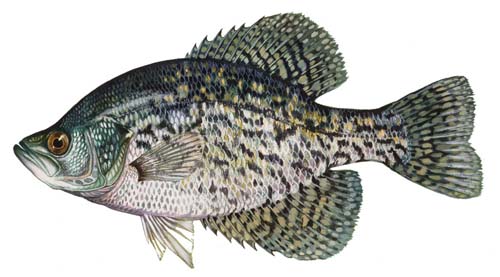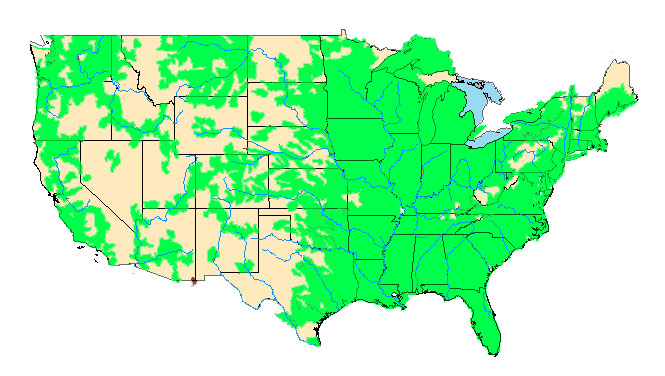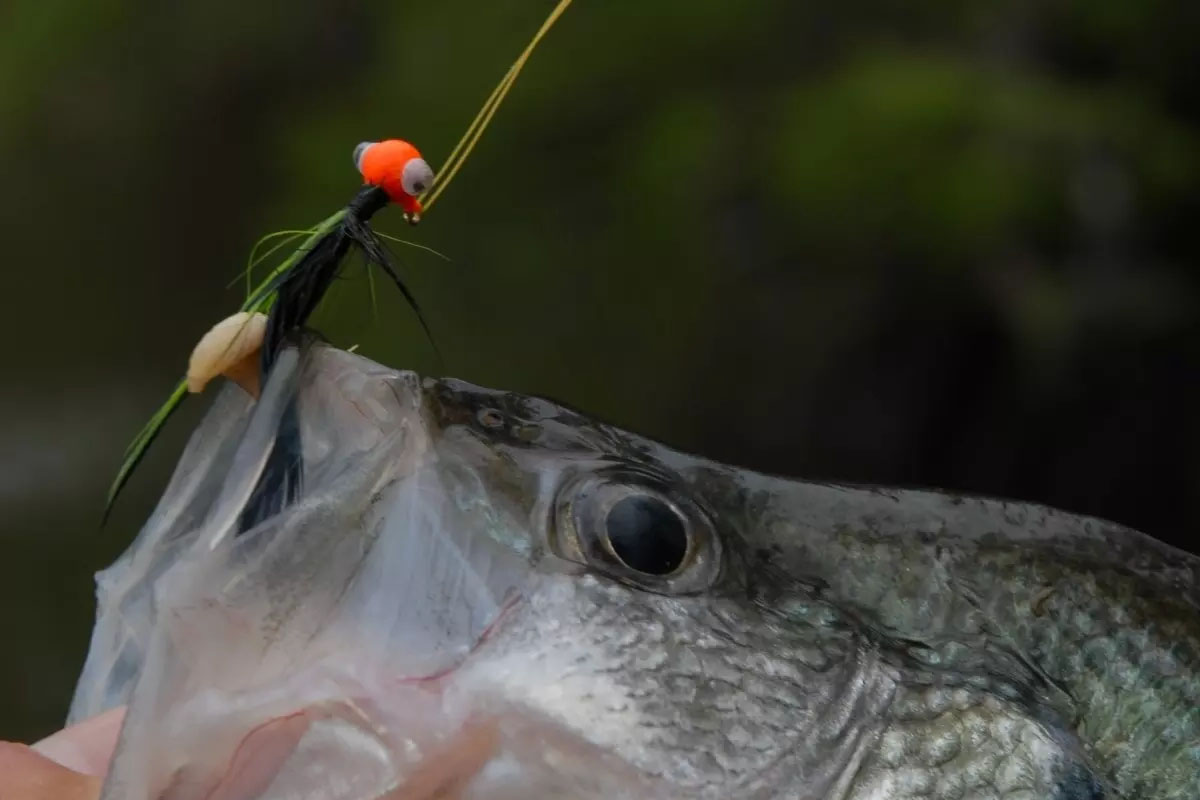Black Crappie is a popular game fish located throughout North America in rivers, lakes and shallow waterways among vegetation, bushes or other cover. Effective fishing techniques include vertical jigging, bait casting and drift fishing with bait and lures.

Habitat: Lake, Pond
How to identify Black Crappie
Both black and white crappies are often confused with one another. They have the same coloring and markings – dark olive or black with spotted silver sides. The easiest way to tell the difference between the two is by looking at the pattern of the spotting. On a black crappie the spots are irregular and scattered across the body. White crappies have more subtle spots arranged in vertical bars on their sides. The black crappie also has 7-8 dorsal spines, while the white crappie only has 6. The body of the black crappie is more rounded, where white crappies’ bodies are longer.
Where to catch Black Crappie
Black crappies are native to most of the eastern half of the United States. The black crappie has been transplanted so widely that it can be found throughout the United States and even into southern areas of Canada. However, in the part of the Midwest that reaches from western Texas up through Nevada, Colorado, Utah, Wyoming, Idaho, and western Montana, the fish is not as abundant. In this region it’s possible to find them along the borders of these states or in limited areas within.

Black crappies live in large, shallow ponds and lakes. Although they frequent shallow areas, they require deeper, cooler habitats than the white crappie. They prefer sandy or muddy bottoms and abundant vegetation.
Crappie spawn in early spring when water temperature reaches about 55 degrees fahrenheit—which may be anywhere from February to May depending on the region. Crappie move from their deep water haunts where they’ve held up for the winter to the shallows to feed and spawn. As summer arrives, and temperatures climb even higher, crappie return to deep water.
Crappie typically spawn near some form of cover including vegetation, grass edges and pockets, laydown trees, even stumps. These are the areas you want to target during spring. But where crappie spawn will really depend on available habitat.
You’ll find crappie at depths anywhere from 2-12 feet during early spring and spawn when temperatures are in the prime temperature range. When water clarity is low, you may find crappie a little closer to shore at depths of 2-6 feet. When water clarity is high they’re usually a litte deeper offshore.
It was once thought that cover was the best place to find larger Crappie, but newer evidence suggests that large crappie are just as likely to be suspending or roaming throughout the open water as they are to be hold up near cover. Some of the largest crappie catches on record did not relate to cover at all.
Knowing that crappie can be found just about anywhere—shallow cover, suspending, roaming, or deep cover—you need to be familiar with several techniques for catching these fish under various conditions and habitats.
The following are habitats where you can catch Black Crappie:
- Freshwater Weed Beds
- Gradual Shores
- Lake and Pond Fishing Holes
- Inlets and Outlets
- Open Water
- Piers, Docks and Pilings
- Shoreline Shallows
- Springs Holes
- Sunken Objects
- Walkways and Bridges
Best Techniques for Catching Black Crappie
Black crappies are relatively easy to catch and will often go after a bait as soon as it hits the water. There are several methods for catching crappie. A few of the more common techniques include vertical fishing a jig tipped with a soft plastic, fishing a minnow or shiner beneath a bobber, casting beetle-spin and spinnerbait lures, lone line trolling, and spider rigging.
Smaller crappie will take worms and insects. Larger crappie prefer minnows and minnow immitating lures. During early spring crappie can also be caught fishing the shallows with a fly rod and dry fly. Fly fishing a wet fly works better when crappie move to deeper water. Top water lures and poppers are effective just before sunrise and after sunset.
Vertical Jigging
Ninety percent of the time you can catch a crappie with nothing more than a simple vertical jig. It’s the only way I fish crappie other than bait casting with a bobber from time to time. Vertical jigging from a boat over structure is the also the single most popular technique employed by anglers for targeting crappie.
The essense of vertical jigging is to raise and drop your lure in the water column in fast and erratic way to entice a strike. The angler allows the jig to fall through the water column for a distance and then “jigs” it back up while twitching the rod to create action that attracts crappie.
There are a few different variations of the vertical jig that can be employed when fishing for crappie.
- Up and down: Lower your lure to the strike zone. Lift your rod tip up 2 feet then drop back down. Repeat. (Traditional technique.)
- Swimming the jig: Lower your lure to the desired depth. Move your lure back and forth.
- Dead sticking: Lower your lure to the strike zone and hold it still.
- Bumping Cover: Bump your jig against vegetation, stumps, and cover to elicit a bite. (Take care not to tangle your line.)
- Pendulum: Pitch your bait out and let it sink back to vertical position creating a pendulum motion.
One of the biggest advantages of vertical jigging over other fishing techniques is depth control. You have complete control of the depth your lure sits in the water column. This allows you to work the entire water column and target wherever depth Crappie may be holding.
Vertical jigging works in the summer when temperatures are warmer and crappie are active, as well as during winter when crappie are under the ice and less active.
Bobber Fishing
Fishing a bait or jig under a bobber is a tried-and-true classic presentation for catching crappie at just about any time throughout the year. Bobber fishing for crappie isn’t as popular as jigging, but it’s still an effective technique and one that many anglers enjoy.
The bobber rig is a very simple setup. In it’s simplest form, bobber fishing involves fishing a bait suspended in the water column at a set depth under a fixed float bobber which sits on the surface. Either baited hook or jig can be fished under a bobber.
A fixed float bobber setup can be used to fish a bait or jig at various depths, but is typically used for fishing the shallows. It’s a popular setup for targeting crappie during spawn. Set your jig or bait about a foot or two below your bobber and fish it over spawn beds to catch male crappie guarding their nests.
When targeting crappie over deep cover switch from a a fixed float bobber setup to a slip bobber. The slip bobber allows for easy depth adjustment so you can move your lure up and down in the water column. Just change the location of the bobber stop on your line to lower your lure to the desired depth.
A slip bobber in combination with an electronic depth finder is the ideal setup for crappie fishing. Use the depth finder to identify offshore cover and depth where crappie are likely holding. Adjust the line beneath the slip bobber to target length to get your bait about foot above where crappie are holding./fishing-rigs/slip-bobber-rig/
Spider Rigging
With Spider rigging six to eight polls are trolled from the bow of the boat with two jigs or baited hooks on each line. This approach allows the angler to cover a lot of water with multiple presentations. With multiple lines in the water, you’re also able to fish multiple depths to get where crappie are holding. For Spider Rigging the boat should be trolled relatively slow between 0.1 and 0.5 miles per hour over underwater structure, brush piles, creek channels and points.
Long Line Trolling
For Long Line Trolling six to eight polls with two 1/32 to 1/4 tube jigs or curly tail jigs per line are trolled from the back of the boat at multiple depths. Having this many lines in the water greatly increases the chance of getting in front of crappie and getting a bite. For Long Line Trolling the speed should vary between 0.5 and 1.5 miles per hour as you troll over flats, ledges, main channels and structure.
Long line trolling is one of the few crappie fishing techniques that works all four seasons—including winter when crappie are most lethargic. When long line trolling for crappie during the winter the key is slow down and use baits that will elicit more aggressive strikes. During spring spawn troll the shallows between 4 and 8 feet with 1/16 to 1/8-ounce brightly colored jigheads. During summer, when crappie are most active, troll larger profile baits at faster speeds. Anglers will coming troll a 1/8 to 1/4-ounce jighead with 2 1/2-inch soft plastic during the warmest months.
As effective as trolling can be for fishing crappie, it also has a few disadvantages to techniques like vertical jigging. It is difficult to troll through vegetation, brush piles, stumps and deep structure without getting your line tangled or stuck. It’s also a bit more challenging to target fish holding in structure.
Bait Casting (Cast and Retrieve)
A simple baiting casting setup is a common approach to crappie fishing. Bait a hook and let it fly! Actually, there’s a little more too it than that—but not much.
The biggest benefit of using bait casting (aka cast and retrieve) technique is that it allows you to target where you bait will go. During the springtime casting allows you to get your bait up over spawning crappie and reel back over their nesting grounds. Bait casting is also popular for anglers fishing from shore who need to get their bait out on the water where the crappie are.
The following are effective fishing methods and techniques for catching Black Crappie:
Best Hooks, Baits and Lures
Lure, baits and hooks are as diverse as there are methods and techniques for fishing crappie. Generally, you want to use a medium size #2 or #4 hook for targeting your average crappie. For larger crappie I recommend going with a larger #1 hook. This may seem overkill for fishing small crappie but crappie have a relatively large mouth for their size. You can fish crappie with small hooks but you increase the chance of the hook tearing free from the crappie’s mouth.

There a few hook styles I recommend for fishing crappie. My go-to crappie fishing hook is a long shank Aberdeen hook. I like Aberdeen hooks for fishing crappie for three reasons. They’re thin and difficult for crappie to see. They’re good for fishing minnows without killing the minnow. They’re made of bendable light-wire that doesn’t snag as easy when fishing structure. Using an Aberdeen with a long shank will make hook extraction much easier, especially if the hook is swallowed.
What I like about crappie is they’ll readily take bait or a lure. You can’t beat a live minnow on an Aberdeen hook. As simple as this presentation is, black and white crappie go gaga over live minnows. But you’re not limited to fishing minnows. Crappie will take worms, waxies, small insects and grubs. Most tackle shops will offer a selection of live baits for crappie fishing, or you can round some up when you arrive at the lake.
One of the best aspects of crappie fishing in my opinion is that you’re not limited to fishing live bait. You don’t have to go to the bait store or scavenge up some worms before venturing to the lake. Fishing a good selection of artificial lures can produce a high catch rate without the hassle finding and keeping bait alive. It is important, however, to fish the right lures.
When it comes to fishing artificial bait, a jig (aka “jighead”) is hands down my preferred option for crappie. I’ll usually fish a jig tipped with a minnow, but the minnow isn’t necessary. A good jig will pull in crappie year round. Two things to consider when fishing a jig are weight and color.
The most common jighead weight for crappie fishing is going to be around 1/16 ounces. This weight is ideal for fishing the upper to middle water column. It weighs enough to get your presentation down where the crappie are but is still light enough to allow a little finesse fishing. If you’re fishing the lower water column, or deep, you may consider fishing a slightly heavier 3/16-1/4 ounce jighead. Conversely, an ultralight 1/64 ounce jighead is better suited for finesse techniques.
Lure color is your next consideration. Every angler I’ve spoken with agrees that lure color, whether fishing articial or live bait, makes a difference. I’m not sure exactly which colors work best, but the following are a few suggests from the pros to experiment with.
When fishing stained or muddy water go with darker colors. When water clarity is high, clear or natural colors are the best option. Bright flashy colors often trigger a strike where water clarity is high but visibility is reduced due to cloud cover. The consenus is in that color does impact strike rate when fishing for crappie, but you’ll want to experiment to see which colors work best where you’re fishing.
In addition to live bait and jigs, there are few other lures that consistently reel in the crappie. These include jigging hard baits, jerkbaits, crankbaits and spybaits. During the winter, I’ve found that bladebaits fished through the ice will also get bites. Most anglers are going to stick with fishing live bait or jigs, but I’d have these other lures in your tackle just in case you find yourself fishing water where the crappie just aren’t biting.
A word about crankbaits. Crankbaits aren’t typically my first choice of lure for fishing crappie, but there is a time and a place for using them. During the summer months whe crappie are deep and dispersed, trolling a crankbait may be just trick for finding and getting big crappie to bite. Crankbaits can be trolled anywhere from 10-20 feet in the water column. A 2-inch crankbait is recommended when trolling for crappie.
I find jerkbaits to be hit and miss. Rarely would I fish a jerkbait over live bait or a jig, but there are times when jerkbaits shine. If you find a school of crappie that are in a feeding frenzy, drop your jerkbait down and you’ll reel in crappie by the buckets. I recommend 2-hook jerkbaits in the 3-4 inch range. Anything larger and you’re really going to decrease your hookup rate.
Crappie will also hit spinners and a variety of pan-fish jigs. Baits and lures can also be presented using crappie fishing rigs. If you want to try your hand at fly fishing for crappie, it’s a viable option that many anglers enjoy. Classic flys for fishing crappie include woolly buggers, clouser minnows, nymphs and small streamers sizes #8 to #12. Bright colors and flashy patterns tend to perform best when fly fishing.
If you really want to figure out what the crappie in your lake are biting, it’s time to go high tech. Today you can use forward-facing sonar to see exactly how crappie respond to any bait. If you see crappie aren’t responding favorableto your bait, you’ll want to change things up. Try fishing a mix of different baits and colors to refine your presentation and increase your strike rate.
The following are fishing lures, bait and tackle that can be used to catch Black Crappie:
Crappie Rods and Reels
You could quite literally have a separate fishing rod and reel combo for every fishing technique, but this isn’t going to be realistic for most anglers. If I had to choose one rod for crappie fishing it would be a high quality jigging rod since this is my preferred fishing technique.
A good jigging rod will be both sensitive and responsive. This is going to be a fast action rod with medium to light power. A fast action rod isn’t going to have much bend at the tip and will be very sensitive to crappie strikes. Your power indicates where along the rod it will bend, which in this setup will be about midway down the rod.
If you’re going to troll for crappie, you want a sturdy rod and reel combo that can hand the extra weight of several lines and lures, along with substantial drag. A fast action rod with medium to heavy power is ideal. Trolling rods are going be in the 5-6 foot range.
For casting, you’ll want a spinning rod with fast action medium power. This combo will provide enough sensitivity to feel the bites and just the right amount of responsiveness to get a good hookset. Casting rods are going to be a little bit longer, in the 7-8 foot range.



